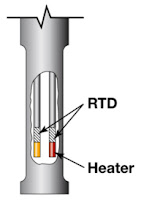 |
| Model TA2 Thermal Dispersion Mass Flow Meter Courtesy Magnetrol |
Compliance with state and federal regulations imposes requirements on numerous industry segments to conduct certain measurements of gas quantities flowing to different points of processing, release, or transfer. The regulatory requirements are stringent, and present a challenge to the manufacturers of mass flow measurement instruments and process engineers to achieve a cost effective solution in the face of:
- Highly Variable Flow Rates - Production can range from near zero to extreme bursts during upset conditions.
- Variable Media Temperature - Depth of the gas source, or another factor, can impact temperature
- Low Process Pressure - The flare headers usually operate near atmospheric pressure
- Variable Composition - The components and density of the gas can change over time.
- Difficult Maintenance - Instruments may need to be installed at locations that are hazardous and not easily accessed
The best mass flow measurement solution will effectively accommodate the challenges at each site. Thermal mass flow measurement is one technology that provides a good approach. Examine the paper included below, documenting performance of the TA2 Model manufactured by Magnetrol. Thermal mass flow measuring devices offer cost and other advantages over several competing technologies.
Share your mass flow measurement challenges with a product application specialist. Combine your process knowledge with their product application expertise to develop the best solution.



